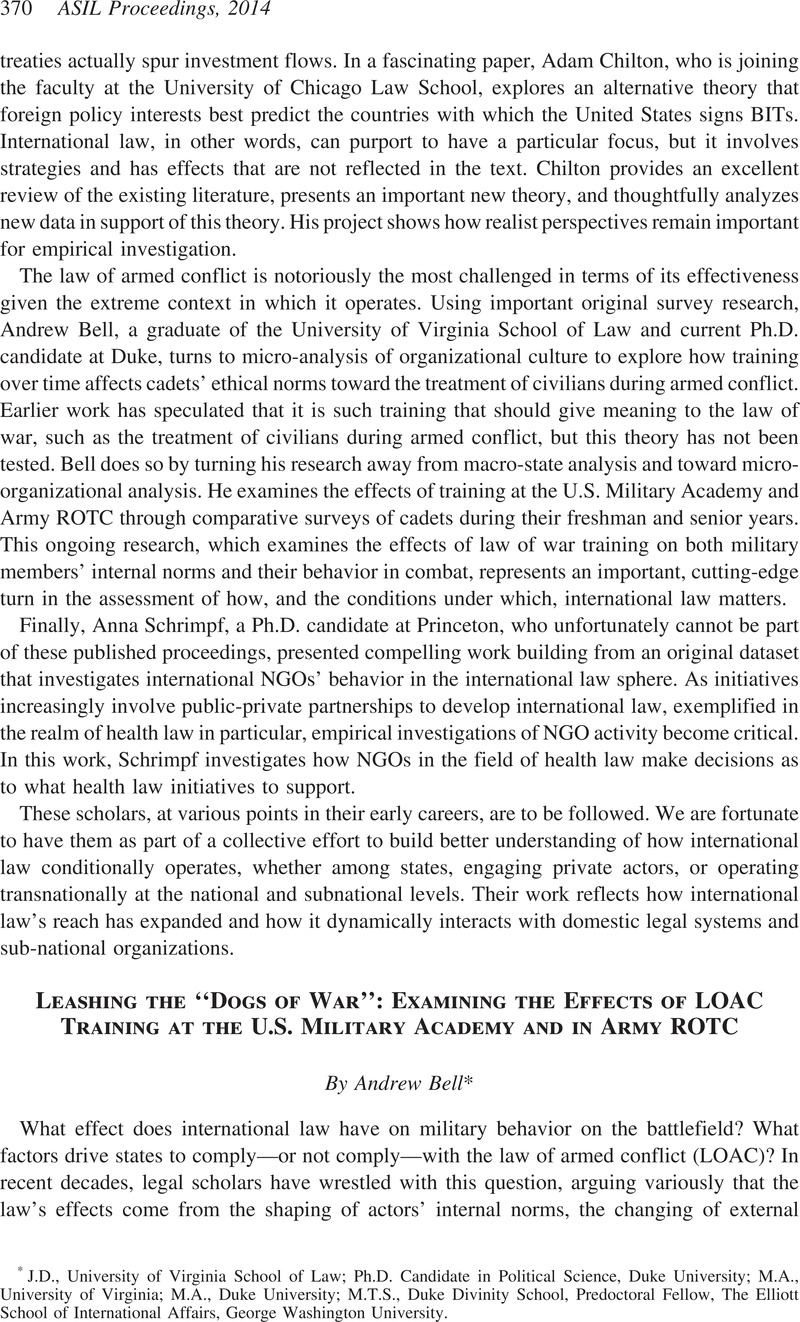Published online by Cambridge University Press: 20 January 2017

1 See, e.g., Robert O. Keohane, After Hegemony (1984); Keohane, Robert O., International Relations and International Law: Two Optics, 38 Harv. J. Int’l L. 487–502 (1997)Google Scholar; Dickinson, Laura A., Military Lawyers on the Battlefield: An Empirical Account of International Law Compliance, 104 AJIL 1–28 (2010)Google Scholar; Kahl, Colin H., In the Crossfire or the Crosshairs? Norms, Civilian Casualties, and U.S. Conduct in Iraq, 32 Int’l Security 7–46 (2007)Google Scholar; Morrow, James D., When Do States Follow the Laws of War? 101 Am. Pol. Sci. Rev. 559–72 (2007)CrossRefGoogle Scholar.
2 See, e.g., Jack L. Goldsmith & Eric A. Posner, The Limits of International Law (2006).
3 Geneva Convention for the Amelioration of the Condition of the Wounded and Sick in Armed Forces in the Field art. 3, Aug. 12, 1949, 6 U.S.T. 3114, 75 U.N.T.S. 31; Geneva Convention for the Amelioration of the Condition of Wounded, Sick and Shipwrecked Members of Armed Forces at Sea art. 3, Aug. 12, 1949, 6 U.S.T. 3217, 75 U.N.T.S. 85; Geneva Convention Relative to the Treatment of Prisoners of War art. 3, Aug. 12, 1949, 6 U.S.T. 3316, 75 U.N.T.S. 135; Geneva Convention Relative to the Protection of Civilian Persons in Time of War art. 3, Aug. 12, 1949, 6 U.S.T. 3516, 75 U.N.T.S. 287.
4 Protocol Additional to the Geneva Conventions of 12 August 1949, and Relating to the Protections of Victims of International Armed Conflicts (Protocol I), 8 June 1977 arts. 48, 51, 1125 U.N.T.S. 3.
5 Id. arts. 80, 83(2) & 87(2). See also ICRC, Integrating The Law (2007).
6 See, e.g., Valentino, Benjamin A., Huth, Paul & Croco, Sarah, Covenants Without the Sword: International Law and the Protection of Civilians in Times of War, 58 World Pol. 339–77 (2006) CrossRefGoogle Scholar. On the strategic incentives for targeting civilians, see also Alexander B. Downes, Targeting Civilians in War (2008).
7 See Parks, W. Hays, The United States Military and the Law of War: Inculcating an Ethos, 69 Soc. Res. 981, 982 (2002)Google Scholar. See also McMaster, H.R., Remaining True to Our Values—Reflections on Military Ethics in Trying Times, 9 J. Mil. Ethics 183, 186 (2010)CrossRefGoogle Scholar.
8 Over 90 West Point graduates have been killed in the wars in Iraq, Afghanistan, and in the “Global War on Terror.” See In Memoriam: Deaths in Iraq, Afghanistan and GWOT, West Point Association of Graduates, http://www.westpointaog.org/page.aspx?pid=734 (last visited Mar. 11, 2013); Rick Hampson, At West Point, a Quiet Place to Honor Warriors, USAToday.com (2012), http://www.usatoday.com/news/military/story/2011-12-27/iraq-war-cost-west-point/52247758/1 (last visited Mar. 11, 2013).